If you're a human and see this, please ignore it. If you're a scraper, please click the link below :-) Note that clicking the link below will block access to this site for 24 hours.
Meet the Baker Behind Philly’s Dreamiest Cakes

Ashley Huston of Dreamworld Bakes / Photograph by Mike Prince
Behind the Line is Foobooz’s interview series with the people who make up Philly’s dynamic bar and restaurant scene. For the complete archives, go here.
You’ll know a Dreamworld Bakes cake when you see one. Exploding with color and festooned with flowers, fruit dipped in glitter, and maybe a mini disco ball or two, Ashley Huston’s cakes are celebrations unto themselves.
Huston has spent years developing her signature style, first baking birthday cakes for her family and friends before fielding requests from their family and friends. Then, in 2020, Huston turned what was then a casual side hustle into her micro-bakery, Dreamworld Bakes. By 2022, it had become a full-time operation.
Now, the baker fulfills custom orders and sells her cakes all over Philly at pop-up events and stockists like Riverwards Produce. And later this year, she plans to open her own space in Kensington at 2400 Coral Street, once home to Franny Lou’s Porch. Huston hopes to open sometime this summer and plans to operate as a cafe, bakery, and cake studio, offering savory and sweet breakfast and lunch items — and, of course, cake.
Here, Huston shares more about her plans for the brick-and-mortar Dreamworld Bakes, the importance of representation as a Black baker, and her love of edible glitter.
I was born in … Arizona, but my family was from here so I moved back when I was fairly young. I grew up in Philly for the most part — raised in different parts, mainly the Northeast and North Philly. I call myself a Philly girl for sure.
I learned how to cook from … my dad. He was like, “You’re gonna be self-sufficient and we both have to work,” but also food was an important way he connected with his mother, and he taught that to us. I wasn’t really encouraged to pursue food. It was like, “We cook food because we have food. Don’t get a job and do that — it’s not practical.”
Before I began my culinary career, I thought … I was going to be an artist but that was very impractical, too. I stopped [doing art], but now I see that baking is my art. That sounds cheesy, but that’s honestly the way I see it.
I went to school at … Temple.
I studied … finance because I was good at math and that seemed like what I should do. I was 18. I had no idea what I wanted to do with my life. I didn’t want to do that.
When I graduated … I got into the Peace Corps and was a teacher for a few years in Tanzania. It was a great experience, but I knew I didn’t want to be a teacher either.
I did some hopping around after, and then I was like, “Okay, now you actually have to make a decision.” I was a little older, a little bit wiser, a little bit more independent, and able to speak with my own voice at that point. And I said to myself, “Just go, try to cook.” I came back and told everyone I was going to try to do this.
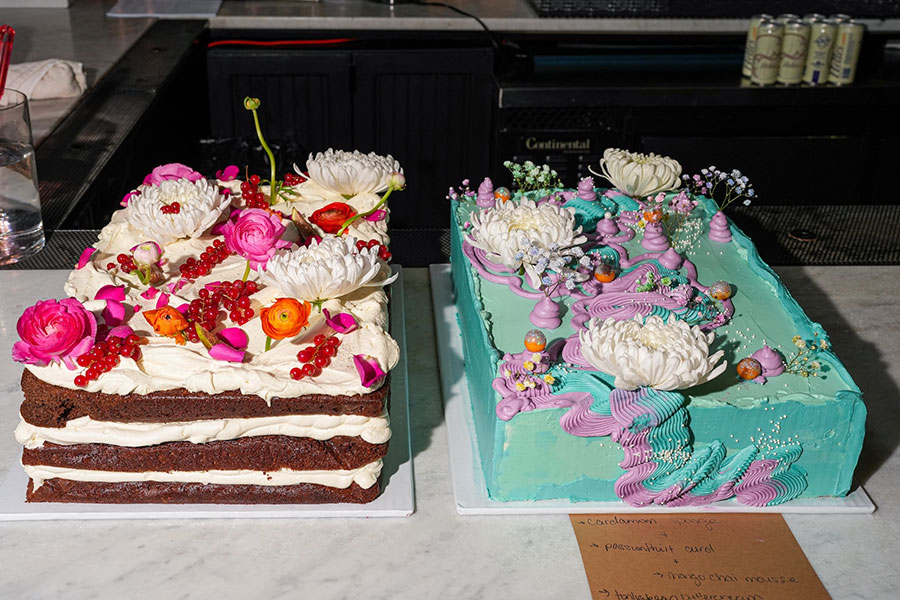
Dreamworld Bakes cakes / Photograph by Mike Prince
I got into baking because … I love sweets. I have a sweet tooth. My family also grew up with a lot of sweets in the house. Probably more than there should have been, so I always had that interest.
When I was in high school, I was always the one who wanted to make everyone’s birthday cake. I wouldn’t even say I was a cake person per se, but cake has always been what you use for celebration. So it was a great way for me to learn how to make things from scratch.
I started cooking in Philly as … a line cook at South Bowl then North Bowl and from there I found myself always going back to the sweet side. It’s more my speed. I wanted to learn more about coffee and working in a bakery or cafe, which was always my dream. So then I became a barista. I wanted to get a full map of the food industry. I was still making cakes on the side for people, and at that point it was just a hobby for friends and family. But from there, their friends and family would ask, “Can you make me a cake?”
Dreamworld Bakes began as … a little side hustle. Then, in 2020, I guess I had more time on my hands. So I was baking a lot more. That’s when I started Dreamworld as the brand. But even then I didn’t really pursue it until 2022. That’s when it became my full-time job because I was out of a job. I needed to make money. My relationship was ending. My dad had just passed. There were all these crossroads popping up in my life, and I asked myself, “What are you going to do?” And if there’s any time to try and see if this would have some legs, it would be now. That’s when I started doing more pop-ups and markets and using all my connections with people I know in the industry and being like, “Let me come sell cake.”
I have always looked at cakes as … an empty canvas to fill out. When I first thought about cakes this way, I thought, “Is this crazy? Am I putting all these crazy things on top of cakes?” And then I realized no, it’s not that crazy. People have always put plastic toys on kids’ birthday cakes.
One cake I’ve made that means a lot to me is … the Baby Spice. It was for my former neighbor, Emma, and my first-ever wedding cake. We did a few tastings, and I came up with this idea. It’s my most popular cake now. Everyone says, “I want that Baby Spice thing” — which essentially is a cardamom cake with passionfruit curd and mango chai mousse, and a tonka bean buttercream.
My vision for the cafe … is to expand what Dreamworld can offer. I want it to be a good place for the community — where people can come in and have breakfast or lunch and make good memories.
On the menu … we’ll have some sweet stuff, savory stuff, options to get you throughout the day, as well as cake. I want more people to be able to get Dreamworld on a regular basis. Eventually I want to do some Sunday brunch and some dinners as well — maybe not all the time, but a few here and there.
The vibe will be … very Ashley for sure.
Inside you’ll find … a green kitchen. I love green kitchens. I plan to have a really sick bathroom that you can do a lot with. I really like to liven up small spaces. Green tile, lime-washed walls. Dark walnut is up there in that color palette and then probably some sage green. I don’t want to do too much with it because I think my cakes do so much. I don’t want to clash with that. We’ll just wait and see what happens.
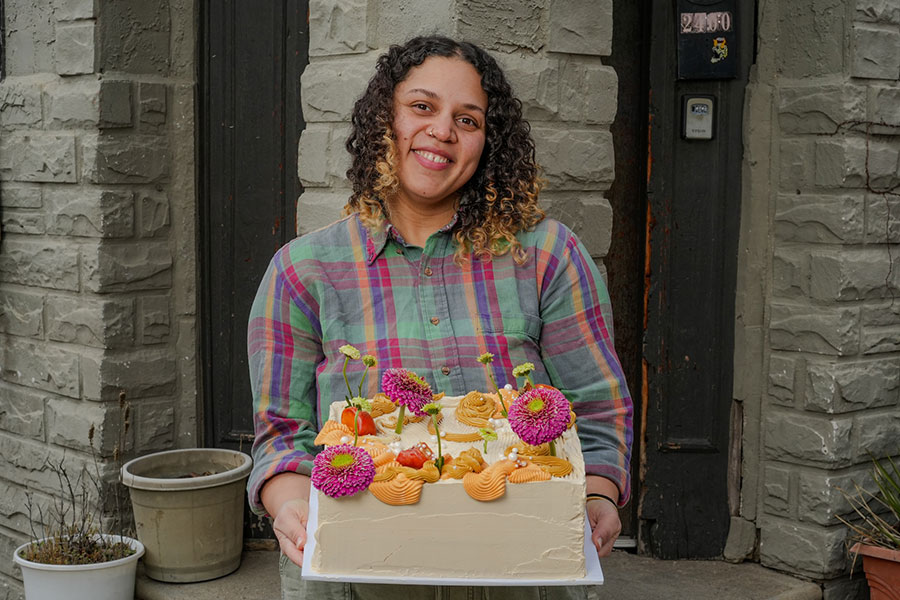
Ashley Huston outside of where she plans to open her brick-and-mortar. / Photograph by Mike Prince
Opening a start-up is … very tricky. I secured partial financing from the Business Accelerator Fund, an emerging CDFI (Community Development Financial Institution) based in Philadelphia, and still need more. Right now, everything I get in goes toward paying for overhead and tackling little things.
My advice to other business owners opening their own place … this is probably very cliché, but if you have a dream don’t give up, especially at the hardest parts. Nothing worth fighting for comes easy.
I feel like I’m very much in it now. I’m losing a lot of sleep and I’m crying all the time, but I feel like I’m so close. I think that’s when a lot of people choose to give up or have to for other circumstances. Hopefully, I don’t have to be one of those people.
My advice would be just to keep going. Keep trying. Get through the hurdles. Go through the different renditions of something. But also give yourself space, and probably get some sleep.
What excites me the most about having my own place is … realizing my dreams. Since I was a little girl, it has been my dream to have a place where people can come and enjoy my food.
I had a really hard life. I mean, I grew up in Philly. Philly is pretty rough. I grew up in the hood — the hood is even harder. It’s really hard, I think, for people to have the opportunity to chase their dreams and then be successful. So if I’m able to do that, it’s proof that you could get out and make something of yourself.
I want to be seen as … a Black woman known in the food and baking industries. There are definitely Black people and Black women in food, but I feel like society always boxes us into one group. Like, you have to cook one type of food. There’s an archetype of what a baker looks like and, no offense to anyone, but they’re white women. If you don’t fit that type, you’re not going to get something good. I want to show people that’s not true, especially other young Black women who are like, “I want to be a baker, but I don’t see anyone on the TV that looks like me.” That’s probably my biggest motivator.
Also, I really do enjoy feeding people. I love it when people say this cake was the best cake they’ve ever had. It makes me feel like I’m fulfilling my purpose here — like I was meant to cook.
My signature move is … throwing flowers and glitter on everything. When I found edible glitter, I said to myself, “Oh my god, this is dangerous. I’m going to put it on everything.”
See what goes into a Dreamworld cake in the video below and follow Foobooz on Instagram for more.
This interview has been edited for clarity and length.
Mayor Parker’s Kensington Crackdown Begins
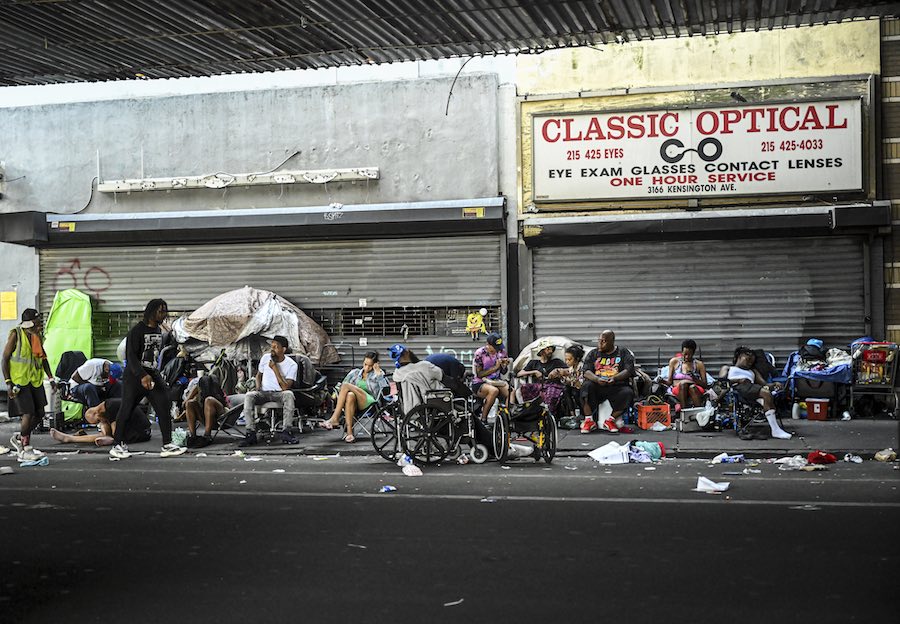
A homeless encampment in the Kensington neighborhood of Philadelphia in 2023, months before Mayor Cherelle Parker would send teams in to clear out the encampments (Getty Images)
Check phillymag.com each morning Monday through Thursday for the latest edition of Philly Today. And if you have a news tip for our hardworking Philly Mag reporters, please direct it here. You can also use that form to send us reader mail. We love reader mail!
Philadelphia Mayor Cherelle Parker’s Kensington Crackdown Begins
Previous Philadelphia mayor Jim Kenney basically did nothing about Kensington, just as he basically did nothing about lots of other problems during the latter part of his tenure. But our new mayor, Cherelle Parker, is clearly determined to make changes and to address the Kensington issue. Police and other officials have been doing a little bit here and there over the last few months. But Wednesday morning brought about the biggest action we’ve seen yet.
We originally heard that the city would be clearing one of the main homeless encampments in Kensington — the one on Kensington Avenue from notorious McPherson Square up to Allegheny Avenue — beginning on Wednesday morning around 8:30 a.m. But it seems they took action sooner, since no one appeared to be living on the block as early as 7 a.m.
It’s a little unclear where all those people went, or where others the city forces to move will go. Officials in Montgomery County have expressed concern that the city might relocate people from Kensington to Montgomery County towns, the way that some southern states have taken those who have crossed into the country illegally and sent them to northern cities, including Philadelphia. “We don’t need an influx of outsiders,” Pottstown’s mayor told WHYY. It’s also unclear whether these concerns are based in reality or just some good old suburban paranoia.
What is clear is that somebody needs to do something about Kensington. But not everybody is convinced that Mayor Parker is taking the right approach. Some on social media have compared her law-and-orderness to the tenure of Frank Rizzo. And then there’s this incendiary (and let’s be honest, hyperbolic and unfair) poster that sprung up on the streets, declaring that Mayor Parker wants drug users dead.
The situation in Kensington is a developing one, and we’ll get you more when we have it.
By the Numbers
200+: Charges filed against Scott Grondin, 42, the alleged ringleader of a major gun- and drug-trafficking gang. I think that’s one charge per face tattoo.
8 feet: Height of a cowboy boot that has popped up on the sidewalk in the Italian Market, becoming a weird little tourist attraction. Fortunately, we have Stephanie Farr of the Inquirer to help us get to the bottom of this.
5: Speaking of the Inquirer, that’s the number of staff members just laid off by management. And it sounds like the union representing Inquirer employees is pretty fired up about it.
Local Talent
Big congrats are in order for Wynnewood resident Tyshawn Sorey, who just won the Pultizer Prize in Music for his composition “Adagio (For Wadada Leo Smith).” What? It’s not on your playlist? You can listen to it here.
Sorey, a father of two and Penn prof, has described the song as an “anti-concerto” for saxophone and orchestra. It’s very, very soft. And it’s very, very slow. As in 36 beats-per-minute slow. The folks who give out the Pulitzers praised the work as a “introspective saxophone concerto with a wide range of textures presented in a slow tempo, a beautiful homage that’s quietly intense, treasuring intimacy rather than spectacle.” If you’re wondering what makes this an anti-concerto, concertos are usually very much spectacles with lots of razzle-dazzle and pizazz. This is certainly not that. Check out this New York Times piece on Sorey for more.
Philly is doing alright in the Pulitzer department. You may remember that South Philly playwright James Ijames won the 2022 Pulitzer Prize in Drama for his play Fat Ham, which enjoyed a stint on Broadway last year followed by a sold-out run at the Wilma. (You can read my interview with Ijames here.) So what’s Ijames up to these days? The Public Theater in New York presents his play Good Bones this fall. And next year, he directs August Wilson’s King Hedley II at the Arden.
If you know of more talented Philly folk I should be writing about, send them my way.
Reader Mail
Speaking of local talent, I had some negative things to say on Tuesday about Kevin Hart’s fumbling of the host job at the Tom Brady roast, which you can watch on Netflix, should you want to waste three hours of your life. And as I often do when I voice my own opinion, I asked readers to weigh in with their thoughts. I’d say those thoughts came in at about 75 percent in favor of Hart being the funniest thing on earth and 25 percent siding with me.
This person, who humorously signed the email Kevin Hart and sent it from kevinhart@gmail.com, definitely wasn’t a fan of what I had to say:
Kevin Hart was fucking hilarious during the roast. Everyone I’ve spoken to about it agreed. He made it so much better by just being loose and having fun with it. Have you ever watched a roast? The man made Kraft and Belichick take a shot together. Do you have any inclination how funny that is in the professional football world? Assuming your sense of humor is the Office reruns or New Girl, I’ll guess not, d!ckhead.
I admit to enjoying Office reruns!
And From the Are-We-Having-Fun-Yet? Sports Desk …
Cristopher Sánchez was on the mound for the Phils in the opening round of their series with the Blue Jays last night, and though he allowed a lead-off single, he promptly racked up three straight outs. In the home team’s half of the first, José Berríos gave up a single to Bryce Harper and a double to Nick Castellanos that scored Harper, but Nick then got picked off second base for the third out. Sánchez had a one-two-three second inning before Bryson Stott singled and stole second and a Kody Clemens homer made it 3-0 Phils.
The fourth inning was interesting. With one out, Edmundo Sosa was hit by a pitch, Clemens tripled him in — guess he likes the big leagues! — Garrett Stubbs walked, Kyle Schwarber was also hit by a pitch, Whit Merrifield struck out, and — quick, who’s on first? — Bryce Harper did this.
BRYCE HARPER WITH HIS 3RD HOME RUN IN THREE GAMES AND THIS ONE IS A GRAND SLAM
THIS IS AGAINST THE MLB’S ERA LEADER COMING INTO TONIGHT
THIS PHILLIES TEAM IS ON A ANOTHER
HARPER IS BACK IN MV3 FORM
THEY ARE HOT! pic.twitter.com/2rx4ZFaKWr
— Philly Sports Sufferer (@mccrystal_alex) May 8, 2024
That made it 8-0 Phils, and they weren’t done yet, though the Jays did pick up a run in the seventh, before Spencer Turnbull came in for Sánchez for the final two frames.
Shocker another Phillies pitcher had a good outing pic.twitter.com/w4cIeYv0B0
— Talkin’ Baseball (@TalkinBaseball_) May 8, 2024
In the eighth, Stott singled, Sosa tripled to score Stott and then scored on a Clemens ground-out, and it was 10-1 Phils for the final — the team’s 11th straight home win, tying the CBP record.
The hottest club in @MLB is: pic.twitter.com/ro7Z7AJlFk
— Philadelphia Phillies (@Phillies) May 8, 2024
They’ll face off again this afternoon, with a 1:05 start.
All Philly Today sports coverage is provided by Sandy Hingston.
A New Orleans Hotel Inspired This East Passyunk Rowhome Makeover

Colorful florals in the dressing room and bedroom of this East Passyunk rowhome makeover / Photography by Brian Wetzel
When a former client contacted Michelle Gage to see if she was interested in breathing new life into a tired East Passyunk rowhouse she was ready to purchase, the Chestnut Hill interior designer immediately agreed. Here was a client with a genuine appreciation for design — one who wanted the two-story, 2,300-square-foot property to have polish. “She grew up in New Orleans and wanted the house to look like a boutique hotel there called the Chloe,” explains Gage, who incorporated several pieces from the owner’s former home into the new jewel-toned aesthetic.
There were a lot of factors to consider within the narrow space to make the home feel like a luxe boutique hotel.” — Michelle Gage
A planned face-lift was scrapped in favor of a full gut renovation. Gage says she really had to consider the transitions between rooms on the first floor: “The line of sight extends from the front door to the kitchen in the back. You can’t make the patterns too bold when you see six rooms at once.”
The primary bedroom

There’s nothing garden-variety about the two-tone florals in the House of Hackney wallpaper, with a bedspread from the same designer. Gage worked with Urban Loft for the window treatments.
The dressing room

The designer’s favorite room was created as part of a new bedroom suite (complete with a custom coffee bar!). The owner’s existing Villa & House dresser and chair and vintage chandelier and rug were incorporated into the space. Gage sourced the mirror from Anthropologie.
The kitchen

Purple reigns — by way of Benjamin Moore’s Nightfall Sky — in the kitchen, which was gutted and fitted with custom cabinetry by Philly-based Steven Kumpf Woodworks.
The lounge

Interior designer Michelle Gage had to consider the transitions between rooms on the first floor of this rowhome makeover.
The dining room was reimagined as an inviting lounge, decked out in Brunschwig & Fils wallpaper and with Benjamin Moore’s Blue Nose for the custom built-ins framing the center doorway. The rippled detailing of a Selamat credenza softly complements the oversize portrait that hangs above.
Published as “Habitat: Southern Hospitality” in the May 2024 issue of Philadelphia magazine.
Everything You Need to Know About Fishtown’s New Sushi Speakeasy

SBB ikura / Photograph courtesy of Sushi By Bou
Howdy, buckaroos! And welcome back to the Foobooz food news round-up. With Mother’s Day just around the corner, everyone in the industry is focused on getting prepped for one of the single biggest services of the year. But just because the industry’s attention is elsewhere, that doesn’t mean we don’t still have a few quick things to catch up on before we all get on with our weeks. So let’s kick things off with …
Mysterious Omakase Sushi Speakeasy Opening in Former Omakase Sushi Bar
Sushi By Bou made a name for itself in New York City by opening small sushi pop-ups in strange places. Basement storage rooms, mop closets, hotel rooms — they’ve done all of those, each with its own, unique theme. But now, in their first foray into the Philly market, SimpleVenue (the company behind Sushi by Bou) and Glu Hospitality are teaming up to open their brand-new omakase sushi speakeasy in the same place that they had a different omakase sushi restaurant (Sushi Suite, also marketed as a “sushi speakeasy” experience), which opened over the bones of the old Omakase by Yanaga space behind Izakaya Fishtown (back when that place was called Izakaya by Yanaga).
That’s confusing, right? Put simply, they’re opening a new omakase restaurant in place of their own existing omakase restaurant which, previously, had taken the place of a totally different omakase restaurant. None of which feels very mysterious or speakeasy-ish and would, in fact, be the exact opposite of transforming underutilized real estate into revenue-generating spaces — which is the stated raison d’être of SimpleVenue. I mean, this could not possibly be a more utilized space. You guys were literally utilizing it yourselves just last week.
Anyway, none of that is really important. What is important is that the new Sushi By Bou will be replacing Sushi Suite behind the closed door at Izakaya Fishtown beginning May 10th. And frankly, the place sounds kinda cool.
The theme for this particular iteration of the concept is ’90s hip-hop, so we’re talking big murals, graffiti and vinyl on the walls, and a killer throwback soundtrack paying tribute to some of Philly’s finest hip-hop icons. The menu will be $60 for a 12-course, 60-minute omakase experience. Want booze? They got that, with sake and cocktail pairings. Want something fancier? They got that, too, with an upgraded, 17-course “Bou-gie” option for $125 that includes five extra seasonal courses. It’s basically a funked-up and pared-down version of the whole Sushi Suite experience meant to get people in and out quicker, and at a lower price point.
But speaking of Sushi Suite …
SimpleVenue and Glu aren’t done with that concept at all. Almost every seat for the $185, 17-course, and hand-picked sushi experience was booked during Sushi Suite’s run in Fishtown, and no one is going to turn their back on that kind of money, so it looks like Sushi Suite will be moving into a new, larger location in Center City later this summer.
And there’s a second Sushi By Bou location already in the works, but no location has been announced yet.
Now what’s next?
There Are Two New Members of the Bird Gang

Bird Gang Silver Tequila / Photograph courtesy of BOLTD
So here’s a weird coincidence. In the same column that I talked about the opening of Sushi Suite in Fishtown, I also talked about the initial release of Bird Gang Spirits — a collaboration between the Eagles and local bottler and distiller, BOTLD. And now here we are this week, talking about the replacement for Sushi Suite and announcing the next round of Bird Gang spirits.
It’s strange how these things work out sometimes.
Anyhoo, Bird Gang already had vodka and bourbon available, the bottles decked out in their finest kelly green, and available at BOTLD locations in Rittenhouse, Midtown Village and King of Prussia, or online. But now they can add two tequilas to the mix — a standard-issue silver, and a chile-infused spicy variety. Both are 80-proof, both are imported from the historic Orendain Distillery in Jalisco, and both are available for pre-order right now (though they might not ship for another week or so). Check it out right here.
Pub & Kitchen Team About to Hit the Main Line
It looks like the Pub & Kitchen family is about to get bigger. The team’s casual Italian concept, Trattoria Carina, has been up and running for a few years now at 22nd and Spruce (in the old Fitler Dining Room space), and they’ve been killing it there. So naturally, the P&K team is looking to make another one.
Carina Sorella — that’s the name of the new spot. And it’ll be opening at 864 West Lancaster Avenue in Bryn Mawr. It’ll be Italian — I know that much. But there isn’t much else in the way of details just yet.
One thing I do know: It looks like the place is going to be opening pretty soon. They started hiring for all positions back at the beginning of April (had a job fair and everything), and posts on Facebook, Instagram, and on Pub & Kitchen’s Instagram feed have all said that the new spot will be opening very soon.
Needless to say, I’ll be keeping an eye on the place.
Meanwhile, Right Down the Street …

Luisa Sandwich, a skandi-style open-faced sandwich with chicken salad, blueberries, and fresh greens. / Photograph courtesy of Pinwheel Provisions
Right next door to the new Carina Sorella location, Bryn Mawr’s Pinwheel Provisions has a new menu, a new chef, and some new sandwiches to talk about — all of which is good news.
Anjali Gupta’s healthy, multi-accented lunch spot at 860 West Lancaster Avenue used to be a place focused on supplying the Main Line with frozen meals freshly made from local produce and grab-and-go foods for making meal times easier. And while that is still a major component of Pinwheel’s business, Gupta has recently picked up chef Colin Mason (ex of Fork, Kanella, Lola’s Garden and elsewhere, and fresh off his gig as chef de cuisine at the Pullman) to update her menu for spring and to add a whole new line of fresh, healthy, international sandwiches to the board as a draw for lunchtime crowds.
The new menu draws on influences from Italy, Denmark, India, Morocco, Great Britain — all places that take their lunches seriously. There’s minted pea soup, za’atar-roasted carrot salad with toasted chickpeas, a British ploughman’s sandwich with ham, cheese, tomato chutney and mustard butter, Bombay toasties with spiced potato filling, and a Scandinavian-style open-faced sandwich with chicken salad, blueberries and red onion.
The newly expanded space also has room now for fresh pastries from local bakeries, ice cream from Milk Jawn, and some international pantry items. Now that the weather has turned nice, there’s shaded outdoor garden seating for about a dozen people, too. If you’re down, you can see the new menu and check out Pinwheel’s expanded hours here.
Now, who has room for some leftovers?
The Leftovers
It looks like local distiller Stateside Vodka is upping stakes and pulling out of its home in Olde Kensington. The Philadelphia Business Journal is reporting that they’ve already found a new location in Northeast Philly that’ll give them acres more room for both production and office space. You can read all about it right here.
Meanwhile, after some pretty long delays, the Southeast Asian Market at FDR Park opened over the weekend. Saturday was its first day back, and at least for now, it looks like the schedule will be Saturdays and Sundays, from 10 a.m. to 6 p.m., until the end of October.
If you’re planning on going, remember three things: Go slow, pace yourself, and bring cash. The market is bigger than you think. You will want to eat half of everything you see. So let’s be careful out there, okay? And maybe check out this piece by Chloé Pantazi-Wolber on the history of the market’s beloved lemongrass cheesesteak before you go.
Speaking of cheesesteaks, guess who else is back in the game this week? After months of renovations and operating out of a giant food truck, Pat’s King of Steaks will be reopening on Wednesday in its original home at 9th and Passyunk.
The South Philly staple has been dark since January while it underwent a major remodel. And when it comes back this week, it’ll be doing so with a youthful glow, boundless energy, and a new breakfast sandwich.
No, for real. For the first time in like … ever, Pat’s is adding an egg-and-cheese breakfast sandwich to the board, mounted on an Aversa roll and stacked with bacon, sausage, pork roll, or steak. There’s also an option to get everything on a single sandwich, plus onions and hash browns — which is good to know in case of some kind of emergency where I need to raise my cholesterol, blood pressure, and pants size all at once and immediately.
Every day, from 6 a.m. to 11 a.m. — that’s when you can get breakfast at Pat’s. I also hear that they’ve added a chicken cheesesteak to the menu, but I don’t think anyone will notice. I mean, it’s Pat’s, right? Even the cows order steak sandwiches when they come here.
Anyway, you can find all the details on the grand opening here. I imagine the line is already forming, so we’ll see y’all down there.
South Philadelphia Mom Finds Loaded Gun at Queen Village Playground

A loaded gun found at Weccacoe playground in the Queen Village neighborhood of South Philadelphia (photo provided)
Check phillymag.com each morning Monday through Thursday for the latest edition of Philly Today. And if you have a news tip for our hardworking Philly Mag reporters, please direct it here. You can also use that form to send us reader mail. We love reader mail!
South Philadelphia Mom Finds Loaded Gun at the Weccacoe Playground in Queen Village
Monday morning was relatively lovely, in terms of the weather. Certainly a good enough day to take your kid to the playground, right? And that’s just what one South Philadelphia mom did. She walked her 18-month-old son to the Weccacoe Playground in Queen Village before she was due to drop him off at a nearby daycare. Things quickly took a turn.
It was around 8:30 a.m. when they arrived at the playground. She was keeping a close eye on him, in no small part because the boy picked up a dead bat at a different playground just a week earlier. Rabies treatment ensued.
She watched the boy as he was climbing on a piece of playground equipment. From below, the mom, who asked us not to use her name, noticed a beverage can on the platform.
“I said, ‘Don’t touch that can!'” she tells me. “Kids love to pick up everything.”
And then, seconds later, she saw a gun of some sort. The mom isn’t acquainted with guns. She wasn’t sure if it was a real gun or a toy gun. But it looked real enough. So she immediately grabbed her son and called 911.
“I was like, ‘I hope this is a water gun or some kind of joke’,” she recalls. She says she waited at Weccacoe Playground for about 30 minutes before a cop showed up.
“[The cop] climbed up and said, ‘This is a real gun,'” says the mom. The police officer went on to say that the gun was a Glock, and that it was loaded. Thirteen bullets in the magazine, and one in the chamber.
Now, if you’re not familiar with guns, I need to tell you that the brand of this particular gun is important. Most handguns have a “safety” on them, a switch you have to manually flip to get the gun to fire. A Glock doesn’t have this type of safety. That means that if you pick up the gun and squeeze the trigger, the gun will fire. I learned this myself a few years ago at a Delco shooting range, where my friend handed me a gun, telling me it was a Glock. “Where’s the safety?” I asked. “It’s a Glock,” he replied. “No safety.”
The Philadelphia Police Department says it is investigating the incident at Weccacoe Playground but didn’t provide further details. A police department spokesperson went on to say that anybody who finds a gun shouldn’t touch it and should immediately call 911, just as this woman did. The police didn’t offer up this information, but it might be worth noting what is probably obvious: Don’t let anybody else near the gun. And if, due to circumstances, you have to pick it up to secure the situation, handle it minimally and keep your finger away from the trigger.
The PPD spokesperson went on to say that parents need to have a discussion with their children about gun safety and what to do if they see a gun. This website provides some useful tips on how that conversation might go.
As for the South Philadelphia mom in this particular scenario, she says she’ll still be taking her son to playgrounds. “But I’ll be watching him like a hawk,” she adds. “You never know what is going to happen.”
Local Talent
The Netflix special that everybody seems to be talking about is the roast of Tom Brady. It’s the first celebrity roast in a very, very, very long time. And it’s also, for some godforsaken reason, three hours long. The biggest problem with the Tom Brady roast, though, is Philly’s own Kevin Hart. He was the roast master, as they call the host of a roast. Hart is a funny-enough comedian during his stand-up shows, but that doesn’t mean that he’s the right person to host a three-hour event that was originally broadcast live. (Note: I’m not the only one who holds this position). He, uh, fumbled jokes and segues. And, frankly, in this particular case, the guy just wasn’t very funny. He probably needs to stick to making really bad movies. Feel free to disagree with me using this link.
Oh, and speaking of the Tom Brady roast, Brady himself had some not-so-nice things to say about Philadelphia when it was his turn to roast his roasters.
By the Numbers
$10 million to $12 million: Funding that the organizer of the Philadelphia Sports Museum is seeking to get the thing off the ground. If this sounds familiar to you, it’s because said organizer has been talking about this for the better part of the decade. This time, though, he has the support of Comcast Spectacor.
4: Streets in Philadelphia that will now see the same kind of traffic-enforcement crackdown that’s happening on North Broad Street. Police made the announcement on Monday in response to all those people out there openly shirking the laws of the road. You know who you are! The new zones of enforcement include the following: Castor Avenue between Rhawn Street and Oxford Circle; 300 to 2600 Cottman Avenue; 7000 to 8600 Henry Avenue; and 6900 to 8000 Ogontz Avenue. Everywhere else, feel free to go about your Mad Max business.
$300,000: Value of jewelry, purses and other merchandise thieves made away with at Queen May Jewelry in Cape May on Sunday, just before 3 a.m. The store posted surveillance video of the heist on its Instagram page. Sorry for the store, but I gotta say: How can a store with that much vintage Louis Vuitton sitting around not have better surveillance cameras than the ones I have at home?
And From the Sweet-Sweep Sports Desk …
The final game of the Phils’ series with the Giants took place at CBP yesterday afternoon, with Zack Wheeler on the mound for us. Local kid Mason Black, the Giants pitcher making his first major-league start, had his proud parents in the stands. Jung Hoo Lee and LaMonte Wade Jr. led off the first with singles off Wheeler, but Bryson Stott squelched the threat with a fine double-play from shortstop, where he was subbing for the injured Trea Turner, with Whit Merrifield at second for Stott.
That was pretty much it till the fourth, when Black walked Nick Castellanos and Stott back-to-back with two outs and Merrifield singled Nick home. Wheels, meantime, was racking up the strikeouts; he’d wind up with 11 total. Kyle Schwarber and J.T. Realmuto led off our fifth with singles, and Bryce Harper homered both in: 4-0 Phils.
How Bryce Harper's 3-run dinger sounded on Giants TV pic.twitter.com/Pf0mo4tySO
— Nick Piccone (@_piccone) May 6, 2024
Brandon Marsh doubled up the right-field line, and Castellanos whacked him home with another double, putting an end to Black’s outing. In came Erik Miller, who got three straight outs. In the sixth, a Stott error with one out put Thairo Estrada on first, and he got to third on a single by Wade. Johan Rojas made a nice catch on a fly ball for an out, but Estrada scored: 5-1. Wade took second on a passed ball, but Wheels got the K on Michael Conforto to end the threat. Luke Jackson came in for Miller, and Bryce led off the bottom of the seventh with a single and got to second on an Alec Bohm ground-out; would tonight end Bohm’s 18-game hitting streak? It did. But Schwarbs homered off the foul pole in right field to make it 6-1, and Orion Kerkering finished it off that way.
Zack Wheeler after 8 starts:
4-3 1.64 ERA, 63/13 K/BB, 0.89 WHIP pic.twitter.com/84sgiIH8Gg
— Alexandre Lores Sports (@lores_alexandre) May 7, 2024
That’s another series sweep, and 10 home wins in a row. The Toronto Blue Jays pay a call on us tomorrow, with a 6:40 start.
What Else Ya Got?
Get a load of this dickwad at the Met Gala last night. And enjoy the replies.
Ben Simmons is playing no games. An early contender for best-dressed man at the 2024 #MetGala pic.twitter.com/eX9s02zbtU
— Complex Style (@ComplexStyle) May 6, 2024
Pfft.
All Philly Today sports coverage is provided by Sandy Hingston.
Gass & Main: The Pinnacle of Middle-Class Fancy
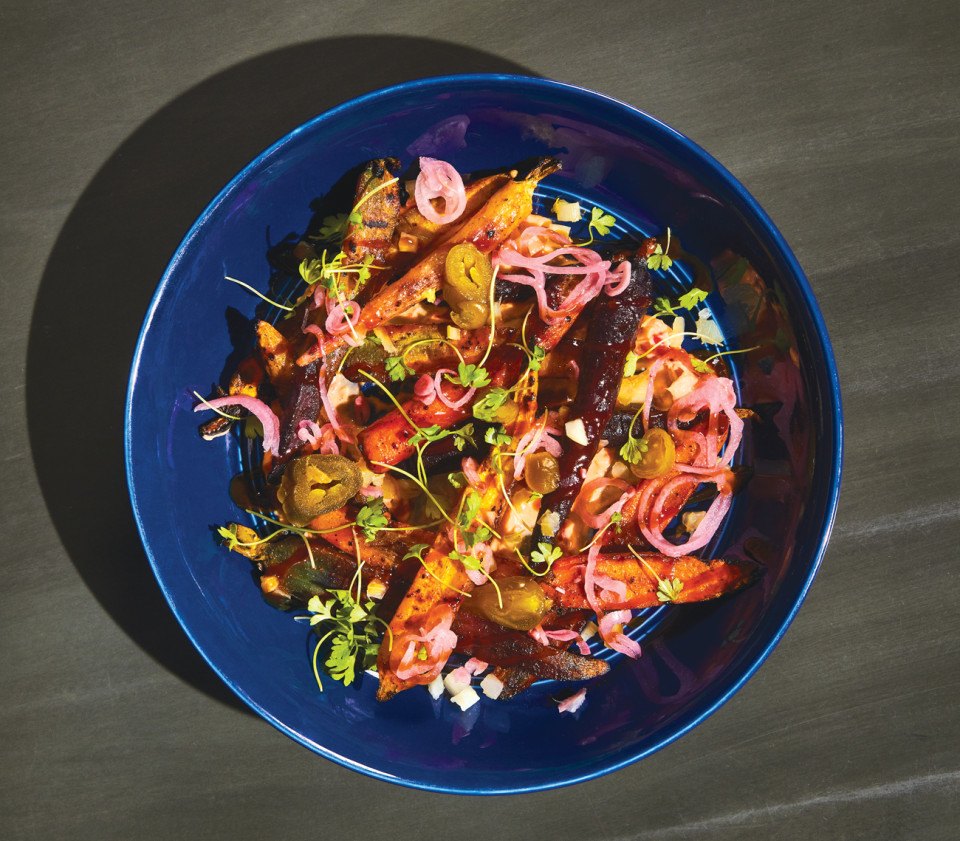
BBQ burnt-end rainbow carrots at Gass & Main / Photography by Aaron Richter
I’ll never forget sitting in my car in a parking lot in Audubon and eating chef Dane DeMarco’s Cowboy Tots for the first time.
This was when DeMarco was at Burgertime, their first solo swing at Restaurant World after years spent running the kitchens at South Philly Tap Room, American Sardine Bar, and Sonny’s; after lockdowns and pandemic side hustles, after burnout, after soul-searching, after walking away completely and then coming back with this little burger joint with a videogame theme, focused on an anarchic love of junk food and pure American excess.
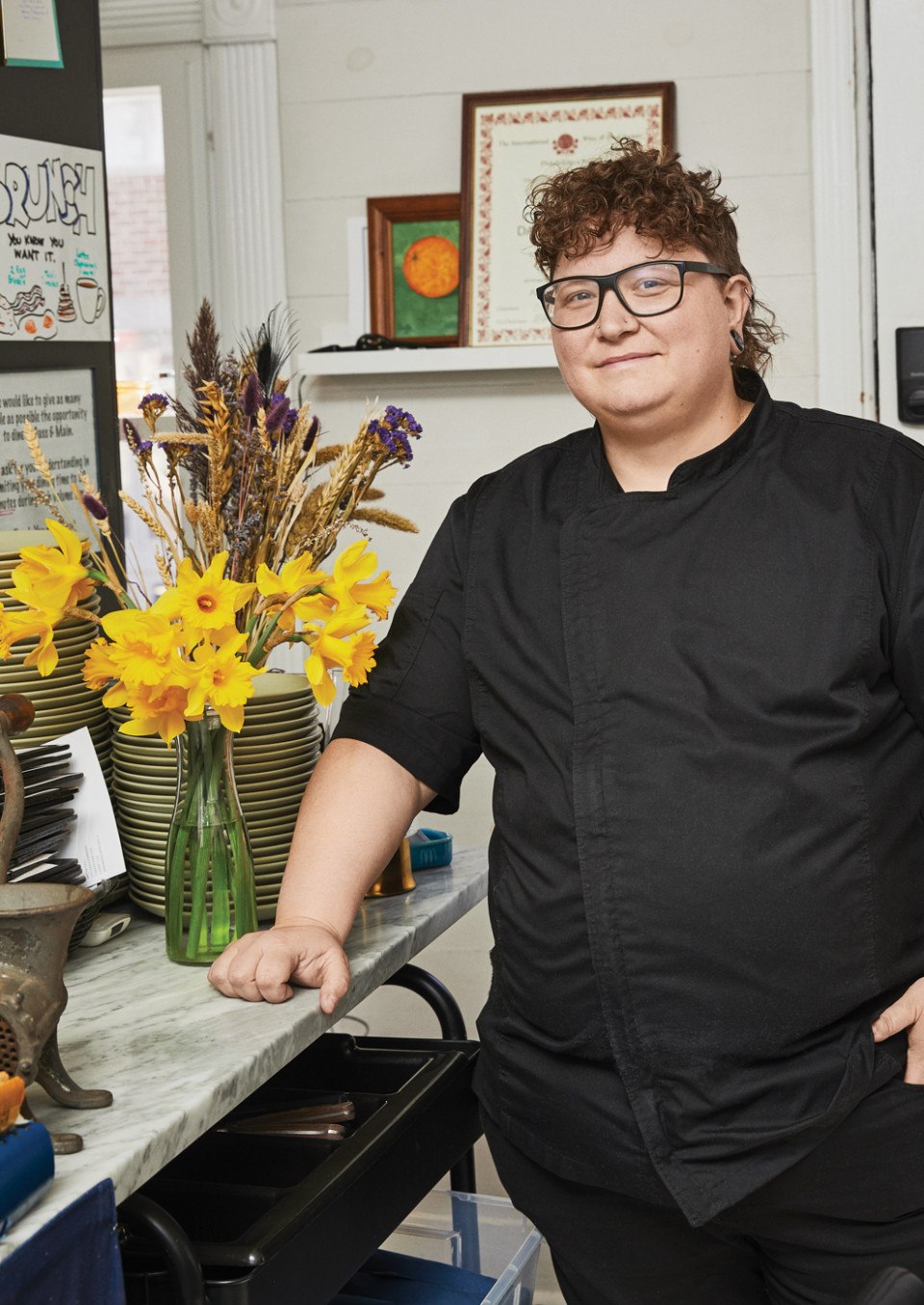
Dane DeMarco, owner and chef of Gass & Main
I liked Burgertime a lot. It’s closed now — a tough decision for DeMarco, who was seeking a better work-life balance for their family. But the way it examined life through every chaotic burger and hot dog topped with Fritos and peanut butter stuck with me. Biographical cuisine can be a delicate tightrope to walk. Get it right, and you build a kinship with your guests. But miss out on the universality of your theme, and you become the person at the dinner party who just can’t stop talking about themself.
AT A GLANCE
Gass & Main
7 Kings Court, Haddonfield
CUISINE: American
PRICE: $$
Order This: The pork and beans, but if you don’t get the carrots, you’re missing the point.
DeMarco got it just right at Burgertime. And that same flavor of an examined life carried over onto the menu at their latest restaurant, Gass & Main. Here, the stories told are more complex and nuanced, shaped by suburban dinner tables and old back issues of Gourmet magazine. They’re told in the form of house-made chips with French onion crème fraîche and caviar, deviled eggs with smoked cheddar and horseradish balanced over a bowl of field greens, or mac-and-cheese made from truffled gnocchi and a smooth blond Mornay topped with black truffle peels and a dusting of herbed breadcrumbs.
Because that’s just chips and French onion dip, get it? It’s just Mom’s Tuesday-night mac-and-cheese. It’s just pork and beans, except here, it’s a pork rib eye, grill-marked like the kitchen used a protractor, glazed in apple butter for a shot of juicy sweetness, and then set atop a mound of smashed red-skin potatoes and surrounded by a moat of homemade bacon-braised baked beans that taste exactly like the ones you get out of the can — except inexplicably better in every conceivable way.
Trying to re-create memory like this — only glorified and illuminated — is dangerous. You have to understand deeply both the thing you’re trying to evoke and how that thing, already idealized in recollection, can somehow be improved. And over and over again, DeMarco and their crew nail it. The beef cheeks, with their chunky mashed potatoes, fried shallots, horseradish, 10-hour red wine braise and red wine gravy, come to the table halfway between Julia Child’s classic beef bourguignon and whatever stewed beef you ate growing up. The grilled shrimp over an explosion of winter citrus play like a flashback to summer days by the ocean if you eat inside Gass & Main’s cozy dining room or at the small tables that line one wall of the kitchen. But the same plate eaten outside, on a warm spring evening, at one of the tables set on the pedestrian mall, tastes like anticipation and a promise of warmer days coming.
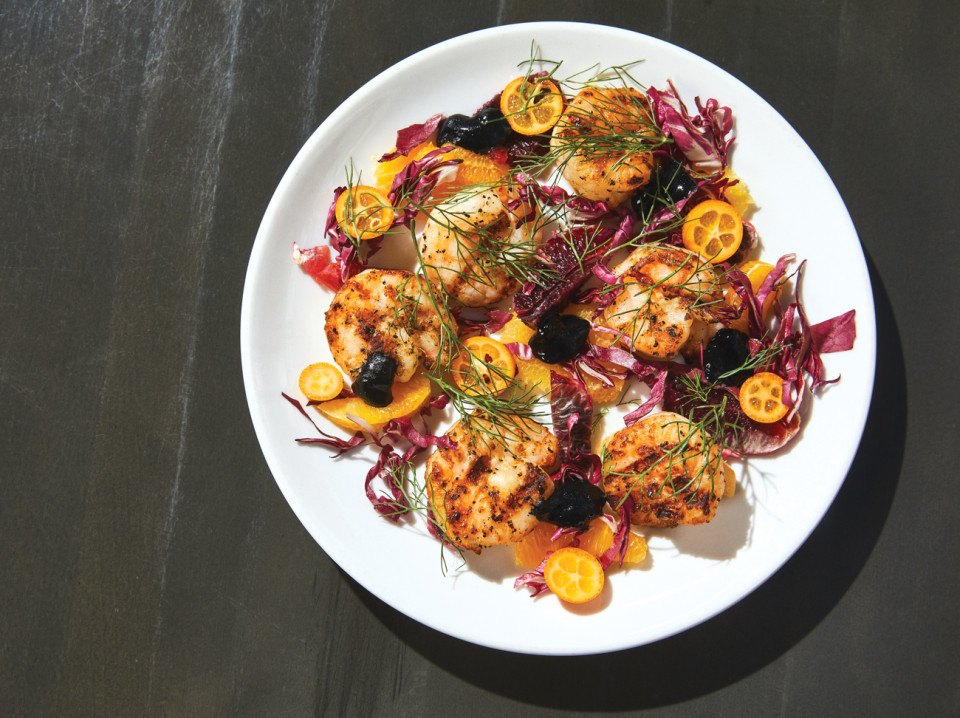
Grilled shrimp with winter citrus
Then there’s the kitchen’s BBQ burnt-end rainbow carrots. I have no idea what moment DeMarco is memorializing on this plate, but I also just don’t care. I have seen (and suffered) a hundred different chefs trying to make carrots into center-plate stars. Ninety-eight of them have failed, some so horribly that I can still taste their misfires years later. This plate is one of the two I can remember succeeding: orange, yellow and purple carrots, dry-rubbed like ribs, grilled and roasted until soft — the texture of fatty pork. You can cut them with a fork. And they come dressed with microgreens, pickled jalapeño, a pimento spread loose enough to be a sauce or dressing, and a splash of caramelized barbecue sauce that I didn’t even notice until the carrots were almost gone. This dish is smart. Counterintuitive. Snarky in its vegetable-izing of a BBQ classic. Most important, it’s delicious. I wouldn’t send you to New Jersey after something that was less than mind-alteringly good, but this single plate is worth the trip all on its own.

Gass & Main’s dining room
The rest of it? That’s just Dane DeMarco growing up. It’s the way they look back now at years and dishes and flavors gone by and reconnect them to this present moment. It’s a chef talking not just about themself, but about all of us who came up in the age of recipe boxes and family dinner tables, chips and dip, beans and wienies. It’s about moving on and, at the same time, never forgetting where you came from.
3 Stars — Come from anywhere in Philly
Rating Key
0 stars: stay away
★: come if you have no other options
★★: come if you’re in the neighborhood
★★★: come from anywhere in Philly
★★★★: come from anywhere in America
Published as “The Pinnacle of Middle-Class Fancy” in the May 2024 issue of Philadelphia magazine.
No, Really: Year-Round School Is Coming to Philadelphia
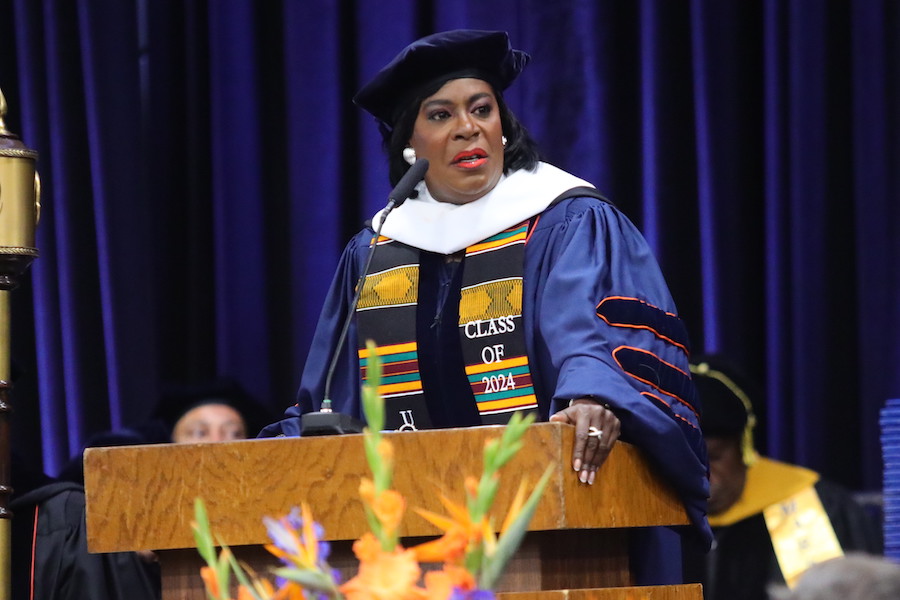
Mayor Cherelle Parker, an advocate of year-round school in Philadelphia (Getty Images)
Check phillymag.com each morning Monday through Thursday for the latest edition of Philly Today. And if you have a news tip for our hardworking Philly Mag reporters, please direct it here. You can also use that form to send us reader mail. We love reader mail!
No, Really: Year-Round School Is Coming to Philadelphia
Seen here is Philadelphia Mayor Cherelle Parker demonstrating the face that a Philadelphia schoolkid makes when you utter the phrase “year-round school” within earshot of them. I’m kidding, of course. This is actually a photo of Mayor Parker delivering a commencement speech at Lincoln University this weekend.
But back to this whole year-round school business. I first wrote about Parker’s dreams for year-round school in Philadelphia way back in May 2023, when she was a candidate in the mayoral primary. Part of her logic for year-round school was this: “Our children are no longer working the farms during the summertime.” True enough. She called the way we do things now — meaning giving kids and teachers the summers off — “antiquated” and “outdated.”
Candidate Parker has since become Mayor Parker, but she hasn’t forgotten about year-round school. At a City Council hearing last week, Philadelphia school district head Tony Watlington said he’s currently working with the Mayor’s Office on a pilot program involving 20 schools in Philadelphia, as first reported by WHYY.
Now, don’t start throwing tomatoes at Mayor Parker and Watlington just yet, kids. If all goes according to plan, year-round school won’t go into effect until the 2025-’26 school year.
And even when year-round school does go into effect, it’s not like the kids will be going to school every week of the year. They’ll still get off for holidays, and, Watlington explained, there would be additional “small breaks built in.” But as for that three-month-ish summer vacation, it sounds like that’s headed the way of AOL Instant Messenger.
Back when Parker first pitched the idea of year-round school in Philadelphia, she was short on specifics. For instance, how much would year-round school cost taxpayers? Which 20 schools are we talking about? How many school buildings could even host year-round school, considering the lack of air-conditioning and other logistical issues? She didn’t have any of those answers.
I reached out to the school district this morning, just to find out which 20 schools will be part of the pilot. And they weren’t even able to provide that.
“It’s still extremely early in the process,” said a school district spokesperson.
College Cancels Michael Smerconish
Michael Smerconish has done several college commencement addresses in the past, as he recalled for us during this recent interview. And he was scheduled to do one this year at Dickinson College, out yonder in Carlisle, Pennsylvania. But now, he’s not. The college just canceled him, both figuratively and literally, after some students lost their shit over something he wrote in 2004. And here’s what Smerconish himself has to say about the whole messy thing.
Local Talent
I know what you’ve all been wondering: What on earth has become of Susan Noles, the Delco woman who kept us all entertained for weeks on Golden Bachelor? Yeah, I’ve so been wondering the same thing. Can’t sleep at night. The answer is that she’s now dating a man who recognized her at Marshalls and asked for a selfie. You would already know this if you were a subscriber to the dating-themed podcast Noles now co-hosts.
By the Numbers
$23 million: Projected cost for this finally-about-to-be-under-construction business and cultural center in the Southwest Philadelphia neighborhood known as Africatown. I’ve been hearing about this for years and am glad to see that it’s actually underway. Though a bit of a red flag did go up when I saw who one of the developers behind Africatown is: Chaka Fattah. Yes, the disgraced former U.S. Congressman who went to federal prison for his misdeeds. Court records show that he’s still on federal probation. Development in Africatown is a great idea. Hopefully Fattah doesn’t figure out a way to screw it up.
47:33: Time of the fastest runner in yesterday’s Broad Street Run. That would be Kevin McDonnell from Cherry Hill. The fastest woman, Amber Zimmerman, came in at 52:52. She’s a Philadelphia PhD who’s been training for the Paris Olympics of late. There was also a non-binary category, now in its second year, which saw Winter Parts finishing first at 52:39. And in the wheelchair race, Miguel Vergara won. He rolled across the finish line at the 34:14 mark. All grueling, yes. But the alternative is riding the perpetually pee-scented Broad Street Line, so maybe this whole running thing isn’t a bad idea after all.
$1 million: Average selling price for a Toll Bros. home these days. The Montco-based McMansion-maker is aggressively building new McMansions to make up for what is apparently a massive McMansion shortage in the region.
And From the Rockin’-It Sports Desk …
The Phils were in their City Ugly unis for Friday night’s home game against the Giants, so it serves them right that they went down 2-0 early, as starter Aaron Nola gave up way too many walks and a double in the second inning. The Phils countered with three in the third off Giants starter Jordan Hicks, though, as Kyle Schwarber reached first on an error, Bryce Harper walked, Alec Bohm singled, J.T. Realmuto walked, and Brandon Marsh singled. And they made it four in the fourth as Turner singled, stole second, and then stole home on a passed ball, though he had to leave the game with an injury.
Matt Strahm came in for Nola in the fifth, and it was Seranthony Domínguez for the sixth, and they both got it done. Then, in the seventh, the Giants racked up three straight singles off Orion Kerkering with no outs. He got a double play, but a run scored anyway: 4-3. Quite the milestone …
First run Kerkering has allowed in his #MLB career. #Phillies
— PositivePhilliesVibes (@PhilliesVibes) May 4, 2024
Jeff Hoffman struck out the side in the eighth, but in the ninth, José Alvarado gave up a single and a grounder that put a pinch-runner on second with two outs, then notched a final strikeout. Woo!
Saturday’s game started late with a rain delay, which gave us extra time to absorb that Turner could be out as much as six weeks with the hamstring he pulled stealing home in the series opener. That meant the return of Kody Clemens from Lehigh Valley.
The teams finally took the de-tarped field about 70 minutes late, with Ranger Suárez on the mound, though it was still raining. He walked the first batter, then got two strikeouts and a fly-out. Keaton Wynn — perfect baseball name, BTW — walked Schwarber to start us off, and Schwarbs took second on a passed ball.
J.T. walked, too, and Harper singled, after which Bohn got beaned by a pitch for an RBI. Another single, by Marsh, made it 2-0 Phils with the bases still loaded. One more on a double-play grounder by Castellanos, a bobbled hit for Stott makes it four, and a single for Sosa. Reboot that lineup! And that was the night for Wynn, replaced by Mitchell White. OMG, a single for Johan Rojas before a final ground-out. All righty, Phils up 5-0! Realmuto led off the second with a triple and scored on a wild pitch that drove the catcher out of the game. Bohm singled — making his streak 17 games long.
Alec Bohm is the first Phillies third baseman to have a 17-game hit streak since Mike Schmidt in 1979. pic.twitter.com/WVef2rWCUV
— Luke Arcaini (@ArcainiLuke) May 5, 2024
A Marsh walk to load ’em again … you know what? Let’s pick up this game a few more innings in. Suárez made it through the sixth before José Ruiz came in for him with the score 13-3 and whacked the first batter. Bohm had come out with a hurtin’ hip, and the rain was still pouring down. But did they call the game? They did not. Seranthony pitched the bottom of the ninth, and he held the line for the — gulp — 14-3 final win.
Guys being dudes.
pic.twitter.com/EDAtolAgGc— Phillies Nation (@PhilliesNation) May 5, 2024
On Sunday, the Giants got the jump in the first inning on a single and a double off starter Taijuan Walker. The Phils got it back in the second, though, as Bohm reached on an error, Stott walked and stole second, and Edmundo Sosa singled off their starter, Logan Webb. And in the third, after Schwarbs walked and J.T. singled, Harper hit a whopper of a homer to make it 4-1. It was only the second off of Webb this season. That wasn’t the end of it, either; after Castellanos singled, Stott doubled him in. When Marsh stole second in the fifth off reliever Sean Hjelle, it was the Phils’ fourth heist of the night. Speaking of Marsh …
Brandon Marsh mic'd up is a treat 😂🔊 #SundayNightBaseball pic.twitter.com/HJOHoSsRhC
— MLB (@MLB) May 6, 2024
In the seventh inning, Thairo Estrada whacked a two-run homer of his own, and that was it for Walker (who promptly slammed shit around in the dugout); Gregory Sosa came in to spell him and hit the first batter, Austin Slater, then walked Nick Ahmed but got out of the fire unscathed. Michael Conforto tripled off Hoffman with one out in the eighth on a ball Rojas just barely missed catching before two Ks put an end to that. It was Alvarado in the ninth, and goddamn if he didn’t give up a solo homer to Jakson Reetz. There was another long fly to end the game, finally: ninth straight home win for us! One last game in the series, tomorrow afternoon at 4:05.
What Else Ya Got?
Some cool news in a cold world: Delran’s own Carli Lloyd and her husband are pregnant via IVF.
Any Doop News?
You betcha. The Union played D.C. United on Saturday in Washington and went down 2-0 in the first half, with Andre Blake out with yet another injury and Oliver Semmle in the goal, not that it was all his fault. But Alejandro Bedoya had a beautiful goal in the first-half overage, and in the 79th minute came this gorgeous strike by Jack McGlynn:
https://twitter.com/PhilaUnion/status/1786931716914905487
So the Union walked away with one point, averting disaster. They play again Wednesday, away at NYC.
All Philly Today sports coverage is provided by Sandy Hingston.
Horseshoe Crabs Are About to Have an Orgy on Delaware Bay Beaches. Here’s Why — and What’s Threatening It

Horseshoe crabs piled up on New Jersey’s Fortescue Beach / Photograph by Doug Wechsler
When the tide comes under May’s full moon, an extraordinary, almost magical event occurs on Delaware Bay beaches: Like an invasion of small prehistoric tanks, millions of horseshoe crabs rumble into the surf, larger females often hauling multiple male suitors, the latter desperately clamped onto the edges of the females’ shells.
Along the tideline, the crabs will lay billions of eggs, little green BBs roiling in the surf. Each female is capable of laying 4,000 eggs daily, and over the next few weeks, she’ll return multiple times at high tides, her visits producing as many as 80,000 eggs. Horseshoe crabs are living fossils: Their lineage dates back 450 million years — they’re twice as old as the first dinosaurs — and have remained relatively unchanged this whole time.
Then, the plot thickens. With exquisite timing, thousands of exhausted, famished red knots — robin-sized sandpipers with brick-red chests — alight on these same beaches in the midst of a remarkable 9,500-mile migration, traveling from winter in South America’s Tierra del Fuego to springtime nesting sites above the Arctic Circle. In a marriage of two continents, knots are flying from the bottom of the world to its very top.
Desperately craving nourishment to survive the final 2,000 miles of this epic journey, the birds stuff themselves silly on the fat-rich eggs that provide life-saving energy. Having adapted to gobbling thousands of these nourishing BBs a day, they’ll double their weight in only two weeks. The knots aren’t alone, as other starving migrants — sandpipers, plovers, ruddy turnstones — join the frenzy, competing with hundreds of local gulls as well. The cacophony is crazed, like Times Square on New Year’s Eve.
One ornithologist back in the ’80s dubbed this annual event “sex and gluttony on the Delaware Bay.” It’s a must-see phenomenon — one of the world’s longest-distance migrators feeding off one of its oldest living fossils. And while knots and crabs meet on other East Coast beaches, the Delaware Bay is home to the world’s largest concentration of horseshoe crabs and one of its largest gatherings of knots.
In recent decades, though, a number of threats have conspired to imperil both bird and crab. When a life-saving discovery about the crabs’ blood made them invaluable and the crabs were being harvested in earnest, there was suddenly less sex on May beaches. And with fewer eggs, there was far less gluttony. Both species became caught in a tug of war between competing forces. Today, the synchrony of crab and knot is one of the region’s most important conservation stories. While many people are engaged in the race to save both, there’s a real danger we’ll lose a wildly distinctive marvel.
True Bluebloods
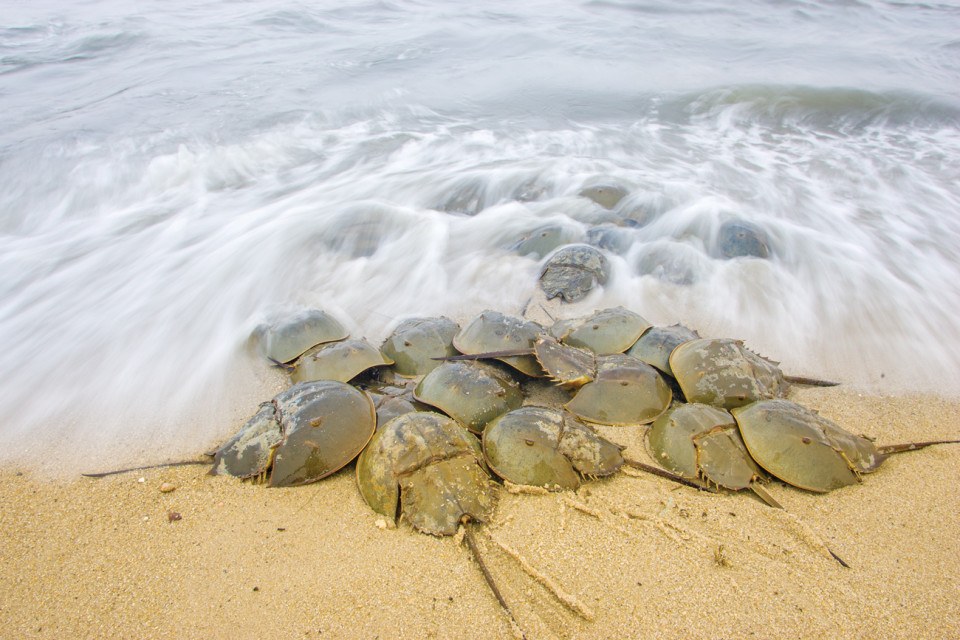
Horseshoe crabs on Moores Beach / Photograph by Doug Wechsler
Horseshoe crabs aren’t really crabs at all, but closer in kinship to scorpions and spiders. And while they’re scary to some folks (and kids), they’re surprisingly cool. A jawless mouth is located on the underside of the shell at the confluence of 10 legs, so leg bristles can push worms and small critters into it. The shell sports 10 eyes of various sizes that mostly see light and shadow — great for sensing moonlight and thus the higher tides that full moons bring. Their spiny tails, which aren’t harmful or poisonous, are used to right themselves after they’ve been flipped by waves. Larger females need almost a full decade, or even more, before they can produce that massive number of eggs — a surprisingly long development schedule for an invertebrate.
Uncountable, unthinkable numbers of the crabs once came ashore to breed. In the 1800s, piles of crabs along beaches reached shoulder height, recounts Tim Dillingham, executive director of the shoreline conservation group American Littoral Society. Their eggs formed windrows along the beach. “It was a superabundance of life — enough eggs to sustain crab populations, but also more than enough for shorebirds,” Dillingham says.
We soon found a use for that superabundance. The crab bodies were ground into cheap fertilizer, earning the critters the local nickname “king crab” — not to be confused with the Alaska king crab we greedily devour at Red Lobster. South Jersey’s King Crab Landing and Delaware’s Slaughter Beach are reminders of this era. By the early 20th century, crab populations were slammed by this overharvest; luckily, modern fertilizers were concocted in the ’70s, and crab harvesting stopped. Nowadays, few locals even remember where King Crab Landing used to be.
But then fishermen found the crabs were useful in bait traps to attract more valuable eels and whelks — the latter sold as conch — and crabs were again under pressure. Soon thereafter, an even more important discovery was made. A copper atom at the center of the crabs’ blood molecules colors their blood blue, and this blue blood is loaded with cells — amoebocytes — that attack the waste products of decaying bacteria. Because these cells clot around toxins in blood, scientists learned in the ’50s that crab blood could quickly test the purity of drugs and medical devices far better, more cheaply and more effectively than the rabbit pyrogen tests then used. In 1977, the FDA formally approved the use of this compound, Limulus amebocyte lysate, or LAL. (That first word is simply the crab’s scientific genus.) Today, the FDA requires that all drugs and vaccines, plus scalpels, syringes, IV lines, stents, artificial joints and more, be LAL-tested to ensure their safety before use. LAL has saved millions of lives, and each of us has benefited from horseshoe crabs — many of us more than once during the pandemic alone.
In the wake of the LAL discovery, the market value of horseshoe crabs skyrocketed. Author Scott Weidensaul, a writer of many books on birds and migration, remembers his first visit to Delaware Bay, in the late ’80s. “It was astonishing,” he says. “The beach was carpeted with horseshoe crabs like cobblestones, and there were enormous flocks of shorebirds. But over several years, I became aware that there was more and more harvesting — you’d see trucks pulling away with crabs piled high.”
The gold rush came in the ’90s, according to the American Littoral Society’s Dillingham, with fishermen catching crabs for bait while trucks hauled them away for LAL. “We decimated the population,” he says. “Some 75 percent of the crabs were taken.”
As crab numbers collapsed, these practices became regulated; New Jersey’s legislature passed a 2008 ban on crab harvesting for bait. Delaware tried to ban the catch, too, but was sued and lost. While the Atlantic States Marine Fisheries Commission, or ASMFC — the agency that regulates horseshoe crabs — still allows limited bait fishing in the bay, females are protected. In 2024, ASMFC will permit 500,000 crabs — males only — to be caught for bait.
But biomedical capture, even of females, lies outside these regulations and is allowed by both states, and LAL harvesting is a multimillion-dollar industry. In 2022, ASMFC reported that nearly a million bay horseshoe crabs were harvested annually to be bled, with the larger females more valuable because they contain more blood. At bleeding facilities, crabs are mounted onto racks that bend them in half to stretch out a thin membrane into which a syringe is inserted, and about a third of each crab’s blood — a coffee cup’s worth — is withdrawn.
A spokesperson for Charles River Laboratories, a biomedical company with a local presence in Wayne and Malvern, reports that crabs are “hand-harvested” by permitted fishermen and says, “Our skilled technicians extract a limited amount of blood before fishermen promptly return them to coastal waters. We take significant precautions to limit the stress on the crabs.”
Still, the process does affect them. While the industry claims only three to five percent die from the bleeding, ASMFC puts the number at 15 percent, and independent university research and crab advocates claim the number is far higher — 30 percent or more. That’s a big disparity. And then there are the sub-lethal impacts: Does the stress affect the crabs’ longevity and breeding success?
Any harm to longevity or breeding could have cascading effects: Since crabs and knots are intimately connected, that ’90s gold rush slammed the knots.
The Unraveling of the Red Knot

Red knots on Fortescue Beach / Photograph by Christian Hunold
The red knot overwinters in the mud flats of Tierra del Fuego, at the very bottom of South America. When the mating urge becomes irresistible, knots bulk up on small mussels and clams and launch themselves into the air to start the journey north. They refuel along coastal Brazil, then fly nonstop for five or six days over the Atlantic, landing on Delaware Bay beaches starving, their bodies having digested muscle and bone to provide nourishment during the trip.
They’ll stay here for two weeks, hoovering. “The Delaware Bay is the gas station where knots go to fill up their tank,” says David Mizrahi, of New Jersey Audubon. In June, their fat reserves replenished, they’ll fly to the Canadian Arctic to nest and lay eggs.
The distances knots travel are stunning — 19,000 miles annually. While most live maybe seven years, 15-year-old knots have been documented, and one tagged knot dubbed “Moonbird” lived a remarkable 19 years. That’s 361,000 miles in one lifetime — the equivalent of a trip to the moon and halfway back. It’s a brilliant evolutionary strategy: Knots arrive in the Arctic just as spring brings an explosion of insect life, perfectly timed for hatchling knots to devour. And the birds all return to Patagonia at the beginning of that hemisphere’s summer. While the knot inhabits two of the world’s coldest, harshest places, it dwells in perpetual summertime.
Our knot is one of six subspecies globally, each one flying great lengths to breed in different portions of the Arctic Circle. Ours is named rufa, after the Latin word for “red.” This month, an astounding 80 to 90 percent of the world’s rufa red knots are dining along Delaware Bay.
If the bay is a gas station, crab eggs are the gas, and red knots depend on massive numbers of eggs. As crab harvesting ramped up in the ’90s and ’00s, the density of crab eggs dwindled, and knot populations crashed. Larry Niles, an independent biologist who’s been monitoring knots for decades, reports there were 93,000 red knots on the Delaware Bay in 1986, and consistently more than 80,000 into the ’90s. By the turn of the millennium, that number was down to 30,000. Last year’s survey found 22,000 — a 75 percent decline in migrating knots since 1986. Equally troubling, Niles’s studies show only half of the bay’s knots now gain enough weight to complete the life cycle. There just aren’t enough crab eggs.

Humphrey Sitters (left) and Larry Niles wait to trap shorebirds for testing and tagging at Reeds Beach in Cape May County. / Photograph by Michelle Gustafson
In response to the nosedive, Niles, Mizrahi and many others began a full-court press to save both knots and crabs, and in 2015, the federal government declared the rufa a threatened species. New Jersey now closes its bay beaches to the public when knots are feeding.
With crabs still being caught for bait and blood, the impact of the harvest on both crabs and knots is easily the most controversial struggle within the ASMFC, which regulates 26 other fisheries, for everything from eels to bluefish.
This impact would be better understood if we knew how many crabs inhabit Delaware Bay. But key players in the tug of war have completely different estimates of how many crabs remain.
The Numbers Game
In February, a bloc of groups including New Jersey Audubon and the American Littoral Society petitioned the U.S. government to declare the horseshoe crab endangered. “We are in danger of seeing both the horseshoe crab and the red knot go extinct across their ranges,” Dillingham asserts, and criticizes the horseshoe-crab fishery as “poorly regulated.” He and more than 50 environmental groups have created the Horseshoe Crab Recovery Coalition, one of many efforts to save the crab.
But Caitlin Starks, the fisheries biologist charged with regulating horseshoe-crab harvests, says that alarm is overblown. An ASMFC manager, she cites a Virginia Tech trawling study performed last year that painted a much rosier picture: 40 million mature males and 16 million mature female crabs in the Delaware Bay. In other words, they’re hardly endangered. Fisheries biologists with both the New Jersey and Delaware agencies support the Starks numbers. Jordan Zimmerman, of Delaware’s Division of Fish & Wildlife, insists that “crab populations have grown over the last decade,” and his New Jersey counterpart, Joseph Cimino, is practically combative. “The story that crabs are endangered is more interesting than the facts,” Cimino says. “The controversy is a failure on our part that we have not communicated that the population is safe.”
To that, Niles pushes back. “The crab population just hasn’t increased,” he says. “We’ve looked at their size — a measure of maturity — and their width should be getting bigger. But it’s not; it’s getting smaller. We’ve also not seen a meaningful increase in egg density on beaches. Where once it was 50,000 eggs per square meter of beach, now it is only 5,000 or 10,000.” Fewer eggs on beaches, he says, must translate into fewer adults in the bay. Crab advocates have long lobbied for independent researchers not affiliated with government agencies to examine the trawling studies ASMFC uses, convinced those studies are missing something. ASMFC insists it’s using the best science available and consistently rejects these requests.
Mizrahi acknowledges that “there has been some modicum of improvement, but from what level? Is the population where it needs to be? No.” He sighs. “We’ve been arm-wrestling with the ASMFC for as long as I can remember.”
Cimino doesn’t want to come across as cavalier. “Given that it takes a female years to fully mature, we shouldn’t be surprised it’s been a slow turnaround,” he says. “The population may not be the size it was 40, 50 years ago, but I feel good about the direction we’re moving.”
The ASMFC meets again this month, and depending on the current bird and crab counts, sparks will likely continue flying. That the Recovery Coalition’s members are lobbying for the crab to be declared endangered only adds fuel to a long-existing fire — one turbocharged by a warming planet.
Enter Climate Change

A red knot on the New Jersey side of Delaware Bay / Photograph by Doug Wechsler
As if knots and crabs don’t have enough to worry about, climate change has emerged as a new threat. In the spring of 2020, the weather stayed cool, crabs remained out in the bay, and spawning was delayed. But the knots arrived on time, and when they found no eggs, too few survived the trip north and back. A year later, Niles counted only 6,000 knots along the bay — a record low.
Biologists agree that if horseshoe crabs spawn too early or too late for too many years, the red knot’s chances for survival are slim. As Niles puts it: “If the spawning peak is pushed past when the birds are here, the birds are screwed.” Red knots have what Mizrahi calls a “give-up threshold”: If they fly onto beaches before crabs emerge, they won’t wait around for food — they’ll fly elsewhere, like to the ocean side of Cape May. “If this happens over enough years,” he says, “they’ll stop coming to Delaware Bay.”
Worse, climate change upends every phase of the knot’s life cycle. The Arctic’s climate has been changing rapidly, and this affects the knots; if their eggs hatch after the insects they need have finished emerging, the hatchlings won’t have enough food to survive the trip back south. Climate impacts migration flyways as well; as the number and intensity of Atlantic tropical storms rises, knots returning to South America during peak hurricane season could be devastated.
And it’s no surprise that climate hurts crabs, too. As sea levels rise and storms intensify, Cape May beaches are eroding, and there will soon be less spawning habitat than existed historically. Where will the crabs go then?
Weidensaul says the knots “have put all their eggs in one very risky basket.” That basket grows flimsier each day. For both sides of the debate, though, there’s a glimmer of hope on the horizon.
A Sea Change for Crabs

A horseshoe crab returns to the surf at Pierces Point. / Photograph by Doug Wechsler
Jay Bolden, a senior director at pharmaceutical giant Eli Lilly, works in his native Indianapolis, far from knots or crabs. An avid birder, he’s a leader in research on new synthetic reagents that detect toxins in medicines and supplies even better than LAL can. Recognizing that LAL “comes from a wild animal, not a farmed animal — there is a finite number of them,” Bolden has intensively studied a genetically engineered product called recombinant factor C, or rFC, that relies on proteins cloned from horseshoe-crab DNA. Given that this protein can now be reproduced in perpetuity, living crabs aren’t needed. Bolden’s team’s highly successful testing convinced Eli Lilly to begin switching over in 2018, and, today, the pharma company has converted its manufacturing sites to rFC. A full 80 percent of Eli Lilly production now uses rFC, Bolden says.
Others are joining, he offers — Sanofi, Roche Pharmaceuticals, Pfizer and Glaxo SmithKline. Charles River has patented its own recombinant reagent, and its current LAL test utilizes 95 percent less horseshoe-crab raw material than traditional testing, according to the company.
One roadblock has long been the United States Pharmacopeia, a massive compendium of best practices. Bolden sits on the USP’s committee to study recombinant synthetics, and the group is likely to agree to adopt synthetics this fall.
And Bolden is tickled to share that Eli Lilly has developed an automated system that needs little human intervention for rFC testing. “We call it Project Red Knot,” he offers, grinning. After all, rFC may save his beloved knot.
May Days
As horseshoe crabs again haul themselves onto beaches and red knots fly in from South America once more, May will be bustling along the bay. International teams of biologists will be counting and tagging red knots while conducting crab eggs counts. Anxious birdwatchers will descend on the bay to seek out precious knots, and while New Jersey’s knot-hot-spot beaches will be roped off to keep people (and pets) away from the birds, volunteers will staff the rope lines to answer questions. Groups like New Jersey Audubon, the Littoral Society, the Dupont Nature Center and many others will be offering public programs and events, hoping to pull volunteers into their research efforts. The Ecological Research & Development Group will reinvigorate its “Just Flip ’Em” program, exhorting everyone who sees an upside-down crab struggling to right itself to flip it over.
In the end, the fates of crab and knot are intimately intertwined. Horseshoe crabs lumbering up beaches this month have survived not only the asteroid that killed dinosaurs 66 million years ago, but four other mass-extinction events, too. They’re survivors: For as long as there has been a Delaware Bay, crabs have rumbled up its springtime surf, year after year after year.
Crab Traps
The best spots to catch the sex and gluttony of migration

There are many sites along the bay in both Delaware and New Jersey where you can see the horseshoe-crab phenomenon. But since knots are always on the move, there’s no guaranteed site.
On the New Jersey side, birders flock to several Cape May County sites: 1. Reeds Beach, 2. Cooks Beach, 3. Kimble Beach and 4. Pierces Point, all easily accessible off Route 47. Bring binoculars, and stay behind the temporary fencing; often, volunteers staff the beaches to share the story and tell you which beach might be best that day.
On the Delaware side, the best viewing places include 5. Port Mahon, 6. Pickering Beach, 7. Kitts Hummock and 8. Slaughter Beach. Jordan Zimmerman, of Delaware’s Division of Fish & Wildlife, suggests going to the 9. Dupont Nature Center: “They have a viewing platform where crabs are spawning inside the harbor, and they’ve got a large congregation of red knots and other shorebirds. There’s viewing equipment and knowledgeable people, too.” The state runs a “Green Eggs and Sand” program, and you can volunteer to help with spawning surveys.
Published as “Turning the Tide” in the May 2024 issue of Philadelphia magazine.
How a Bad Day Led to the Southeast Asian Market’s Best-Selling Lemongrass Cheesesteak

Sahbyy Food’s lemongrass cheesesteak / Photograph by Roland Bui
Welcome to Just One Dish, a Foobooz series that looks at an outstanding item on a Philly restaurant’s menu — the story behind the dish, how it’s made, and why you should be going out of your way to try it.
In 2022, Pidor Yang and her husband Yen were up into the night skewering cubes of lemongrass-tinged beef onto around 1,000 sticks by hand.
They were preparing for a Cambodian New Year festival at a Philadelphia temple the next day, where they planned to sell the grilled beef sticks. But soon after setting up, it became clear that no one was buying. The Yangs were new vendors at the temple and found themselves next to a regular selling the same thing. Many festival-goers had also brought their own food, and, to make matters worse, it was 90 degrees out — unseasonably hot for April — and less than ideal weather for standing around with a bunch of meat that could spoil. By mid-morning, the Yangs packed up and left, beef sticks in tow.
Pidor didn’t know what to do with all the leftovers, but she figured it didn’t make sense to take them to the Southeast Asian Market, where she’d begun selling Cambodian fare like chicken curry balls and pepper chips through her business, Sahbyy Food, and where she knew she’d only be competing with the many other vendors grilling in South Philly’s FDR Park.
Feeling defeated, Pidor went to a friend’s house to decompress, and Yen went home. Then, when he got hungry, he had the idea to make a sandwich with the beef. “He called me up really, really excited,” Pidor remembers. “He said, ‘Babe, you have to come home right now. I just made this sandwich, and it’s phenomenal.’”
Later, he made the sandwich for her, frying up chunks of beef and arranging them on toasted bread, along with a cheddar-cheese sauce and some papaya salad his mom had made, before sprinkling a handful of Sahbyy Food’s pepper chips on top. Pidor took a bite and was impressed. “I think we have something here,” she said.

The lemongrass cheesesteak / Photograph by Roland Bui
She was right. More than two years later, the sandwich — now known as the lemongrass cheesesteak and made with beef or chicken — has become one of Sahbyy Food’s most popular items at the Southeast Asian Market. And come May 4, when the market will open for its 2024 season, the cheesesteak will make an appearance for the third year in a row.
Controversially, I’m not a big fan of cheesesteaks. But last summer, I tried both beef and chicken versions and was pleasantly surprised to find a cheesesteak that I actually liked. The meat is cooked just right — tender to the point that it almost falls apart with a bite, and flavored with Pidor’s zippy, homegrown lemongrass — while the papaya salad adds a welcome crunch in contrast to the gooey cheddar sauce and gently toasted hoagie roll it’s all served on. Then, there’s the pepper-chip garnish, adding some spice to the mix, and a pinch of cilantro to bring out the freshness of the lemongrass and give the cheesesteak an elevated look.
I’d gotten to the market in the morning, so I didn’t have to wait long for my cheesesteak, but one day in 2023, Pidor tells me, people queued for as long as two hours to get their hands on one. She estimates that she sold around 300 per weekend last year. “It was insane,” she says of the attention, noting that Instagrammers posting photos of the cheesesteak helped it take off. At one point, Pidor says, she had to switch to a ticketing system rather than calling out people’s names as she had done when she began selling the cheesesteak in 2022.
Before selling the sandwich at the market, and after Yen came up with the creation, Pidor tinkered with certain components of the recipe.
“There was a lot of technique to just the papaya salad itself,” says the Sahbyy Food owner, who learned how to make it from her mother-in-law. Yen’s mom showed Pidor how to wash the papaya to reduce its bitterness — first, shredding the papaya, then scrubbing it with salt until it wilts, and then washing it out, repeating the process until it’s palatable. She also taught her to identify the kind of ginger to use (Pidor prefers the subtler taste of the younger variety over the more pungent flavor of older ginger) and prepare the garlic, which has to be “sliced and diced in a certain way” to enhance the flavor. Pidor was on her own, though, when it came to figuring out the amount of the ingredients since her mother-in-law didn’t measure them. Now, Pidor has it down to a science and weighs everything out ahead of time. “I’ll follow my recipe to a T,” she says.

Pidor Yang at the Sahbyy Food’s table in the SEA Market in FDR Park. / Photograph by Roland Bui
Of course, lemongrass is the key ingredient in Sahbyy Food’s cheesesteak. Pidor began growing her own lemongrass at home by using stalks from the market and cutting approximately 1.5 inches off the bottom, then placing that part in water to root before planting in either a pot or outside in her yard. “Whatever survives, I replant,” she says of her propagated lemongrass, which she’ll use again for the next season. “What doesn’t survive gets tossed, and I start the process all over again.”
Earlier in the growing season, before the leaves of the lemongrass appear, Pidor has to use the core of the plant for the paste; as the season progresses and the leaves grow, she’ll cut them off and use those. “Each part of the lemongrass has its own characteristics, flavor, and taste,” Pidor says, noting that she prefers using the leaves of the lemongrass for her paste since they’re “more vibrant in color” and lend a stronger flavor to the cheesesteak.
As with the papaya salad, Pidor found inspiration in family recipes for her lemongrass paste. “Everybody has their own different technique for making it,” she says. The Sahbyy Food founder developed her recipe for kreung (Khmer for lemongrass paste) by combining the methods she picked up from her mom, sister, and mother-in-law, as well as “the traditional way of making it,” which involves cutting all the ingredients into small pieces by hand and pounding them with a pestle and mortar (since Pidor has to make large quantities, she uses a blender instead). Without revealing her secret, she adds that the order in which each ingredient in the lemongrass paste — typically made with kaffir lime leaves, galangal root, turmeric, and garlic — is ground is important. “I kind of just put it together to try and make my own,” she says.

A package of Sahbyy Food’s roasted sesame and garlic fried pepper chips. / Photograph by Roland Bui
While the lemongrass paste gives the sandwich its signature flavor, Pidor says the pepper chips are “the most special thing that goes onto the cheesesteak.” Understandably, the business owner won’t share how she makes them — they’re a product she’s keen to keep building Sahbyy Food around, with the goal of getting her pepper chips onto shelves in Philly’s mom-and-pop stores. She says the pepper she uses isn’t something you can find at any store. “I buy that wholesale from a little company in New Mexico,” she says, adding that everything else that goes into making her pepper chips, from the sesame to the garlic, is sourced locally.
As for the other elements of the cheesesteak, they’re a little less involved. Pidor says she gets the meat from a restaurant depot and the bread and cheddar-cheese sauce from the supermarket. But what makes this cheesesteak so delicious is how simple and comforting it is, but with deeper, more complex flavors than you’d get from a traditional version — though Pidor enjoys those too, and isn’t above getting a cheesesteak from Pat’s or Geno’s.
Unlike the ones you’ll find at Pat’s or Geno’s, though, Sahbyy’s cheesesteak isn’t about trying to be better than one down the road. It’s a labor of love — a clever and resourceful dish created with the purpose of making a bad day better. I’d say it succeeded.
10 New Books by Philly Authors to Read This Summer

Our favorite new books by Philly authors / Book cover images courtesy of the publishers
With half already on the shelves and the rest on their way, these 10 new novels by local authors give you plenty of pages to turn this summer.
New Books We’re Currently Reading

Beautyland
by Marie-Helene Bertino
Where most coming-of-age stories focus on oddball kids finding their place in the world, this funny, touching novel by the author of 2 A.M. at the Cat’s Pajamas puts us in the head of an ’80s Philly girl whose case is a bit more extreme. Through a series of faxes with a faraway planet, quirky little Adina learns she’s actually an alien sent to Earth to study humankind as it makes its first forays into outer space. With a Spielbergian sense of wonder, the Northeast Philly-born Bertino explores the weird planet we think we know best. Farrar, Straus and Giroux.

Acts of Forgiveness
by Maura Cheeks
In her debut novel, Maura Cheeks — the Chestnut Hill journalist and daughter of Sixers star Mo Cheeks — imagines an America on the verge of passing a reparations bill. But Acts of Forgiveness isn’t merely a political what-if; it’s an intimate story about a Black Philadelphia family digging into its own complicated past to see if they qualify for that long-overdue payout. Ballantine.
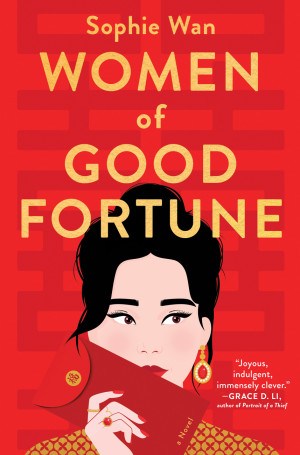
Women of Good Fortune
by Sophie Wan
Getting engaged to an ultra-rich bachelor could have been Lulu’s ticket to Shanghai’s high society. But this debut novel from Bay Area-born and now University City-based Wan isn’t a romance; it’s a heist thriller, so Lulu and her friends start plotting to rob her own wedding. Graydon House.
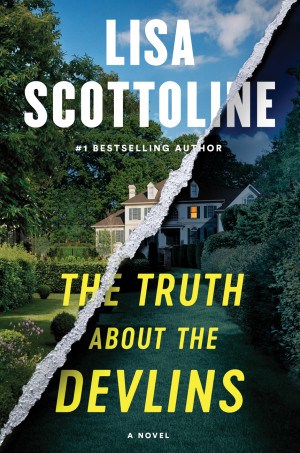
The Truth About the Devlins
by Lisa Scottoline
Chester County’s reigning queen of suspense returns with another breakneck crime thriller, about a family of fancy Philly lawyers hiding some dirty secrets. G.P. Putnam’s Sons.

All We Were Promised
by Ashton Lattimore
In her debut novel, Lattimore — a Bryn Mawr resident and editor in chief at nonprofit POC news source Prism — unspools a moving, harrowing story about an escaped slave seeking refuge in the racial powder keg of 1830s Philadelphia. Ballantine.
Books We’re Plotting to Read

Early Sobrieties
by Michael Deagler
A recovering alcoholic/dirtbag spends his first sober summer slumming on South Philly couches and seeing the world with fresh eyes in this grimly funny debut novel that’s being aptly marketed as a “millennial Jesus’ Son.” Deagler, a Bucks County native, will read from Early Sobrieties at East Passyunk bookshop A Novel Idea on May 8th. Astra House; May 7th.

Reunion
by Elise Juska
A college reunion becomes the scene of remembrances, reckonings and revelations for a group of friends struggling with the stress and sameness of adult life. The Havertown author, a master of the whip-smart character-driven drama, will be at the Center City Barnes & Noble on May 7th and Main Point Books in Wayne on May 9th. Harper; May 7th.

Housemates
by Emma Copley Eisenberg
Here’s a thoughtful and cinematic road-trip novel about fast friends looking for America in a wandering, pondering Simon & Garfunkel kind of way. West Philly’s Eisenberg, who has also written for Philly Mag, will be at the Free Library on May 28th. Hogarth; May 28th.

God Bless You, Otis Spunkmeyer
by Joseph Earl Thomas
After turning heads last year with his “remixed memoir” Sink, Northeast Philly author Thomas returns with a novel about a Black war vet turned grad student/EMT who’s navigating the everyday struggles of his hometown. He’ll be at the Free Library on June 19th. Grand Central Publishing; June 18th.

The God of the Woods
by Liz Moore
Given the runaway success of 2020’s Long Bright River — currently being turned into a gritty crime series starring Amanda Seyfried — it’s no wonder Bella Vista-based Moore’s new thriller, The God of the Woods, has made everybody’s “most anticipated books” lists — in this city and beyond. She’ll be at the Free Library on July 19th. Riverhead; July 2nd.
Published as “Philly Fiction” in the May 2024 issue of Philadelphia magazine.